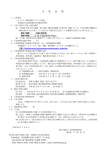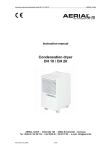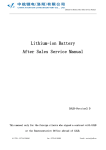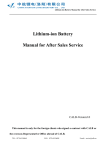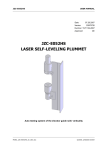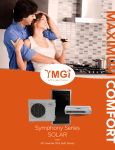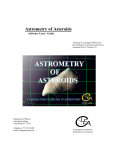Download Anchor WM-900 Service manual
Transcript
WM-450-PT WM-900-PT Commercial Wall Mounted Reverse Osmosis Installation And Service Manual Watts Pure Water 1725 W. Williams Dr. C-20., Phoenix, Arizona 85027 Phone : 888-774-7405 Fax: 602-588-0356 www.wattspurewater.com 1 General Plumbing Layout Includes Optional Pre & Post Treatment Equipment All Pre-& Post treatment equipment shown in this drawing are optional and are purchased separately. 9 9a 4 8 3 7 6 2 22 1 5 1: Pre -Booster Pump (require if the incoming feed water pressure is less than 35 psi (2.2 bars). 2: Water Softener (Recommended if the incoming hardness is greater than 7 grains or 120 ppm of CaCo 3 as hardness) 3: Pre -Ultra Violet Disinfection (Recommended if the incoming feed water is microbiologically unsafe) 4: WM-900-PT with built –in pre -treatment (Shown WM-900-PT) Stage 1: 5-micon sediment Stage 2: 1-micron sediment Stage 3: 10-micron carbon block 5: Tank Tee Kit (Optional) 6: Pressurized Storage tank (Optional) 7: Post-UV disinfection (Optional) 8: Final Polishing final (Optional) Steam Equipment: The final GAC/Calcite filter would be installed between WM and Storage tank. 9: Ozone disinfection (Optional) Note: WM-450 & 900 require a floor drain within 20 feet of unit. Note: WM-450 & 900 require electrical outlet within 8 feet of WM-Control box. 2 1.0 (1) Brass Hex Nipple ¼” FPT INTRODUCTION: WM-Control Box This manual contains important information on the installation, operation and maintenance of Watts WM Series. Watts WM -PT-Series is designed for use with a pressurized storage tank. Proper installation and maintenance will prevent costly equipment downtime. Watts Water Systems Before installing and/or operating Watts WM -Series Reverse Osmosis System, read this manual completely. Keep this manual available for future reference. Further information is available by contacting your local Watts Distributor or STS Department at Watts Pure Water, Inc.-1725 W. Williams Dr. C-20.- in Phoenix, Arizona-U.S.A. 85027-Phone (888)774-7405, Fax: (602)588-0356. Power supply 2.0 Specifications: Motor Solenoid WM-450-PT Production: WM-900-PT Production: 450 gpd 900 gpd TSO switch WM-Module Production based on 77o F water temperature and operating pressure of 150 psi with TDS of 2000 ppm of Na. Feed Back PressureSolenoi Pressure d Gauge Valve Gauge Motor To Drain Recovery Valve 2.1General Guide Lines: Minimum Inlet water pressure:35 psi Water temperature: 36oF pH: 3 TDS: Hardness CaCO 3: Iron Fe: Chlorine: Silt: Turbidity: Maximum 100 psi 100o F 11 5000 ppm 256 ppm 0.1 ppm 0.1 ppm 0.1 1NTU Low Pressure Switch Low Pressure Switch is located behind inlet pressure gauge WM-450-PT Membrane TSO Switch 1/2” or 1” Inlet port 1/2” Flush Valve Permeate Water Line The above operating parameters are a general guideline only. Incoming water chemistry, pretreatment and recovery rate will effect the life and operation of the RO Membranes. Warning; Warranty may be void if unit is improperly operated without proper pretreatment. Stage 1 Stage 2 Stage 3 3.0 Unpacking: Check for shipping damage. Report any shipping damage to freight carrier. Identify the following components: (1) WM -Control Box (See drawing) (1) WM -Module (See drawing) (15) Feet of 3/8” ID Poly tubing (15) Feet of ¼” ID Blue Poly tubing (1) Plastic Connector 3/8”C x ¼” MPT (1) PVC Bell Reducer ½” FPT x ¼” FPT Note: Depending on the Pre- & Post treatment equipment package that was order from Premier. They may be packed in the same shipping container as the WM-System. 4.0 Specifications: 3 Warning: The WM-Module must be firmly secured to a wall that can support the weight of the WMunit during operation. The mounting bracket of the WM-Module has (3) slotted keyholes for mounting the WM-Module to the wall. The head of the screws or bolts should be of a size that can pass through the larger part of the slotted keyhole but not the smaller slotted area that it will slide into. Inlet connection: ½” FPT or 1” FPT Water supply line must be at least ½” service. Incoming water pressure must be greater than 35 psi. Drain Line connection: 3/8” Tubing or ¼” FTP, ½” FPT Permeate: ¼” OD Plastic Tubing M aximum Recovery rate: 1:1 Electrical: 110v/7.2 amps/60Hz (15-amp service) 220v/4.3amps/60Hz (10-amp service) Electrical supply outlet must be with in 8’ of WMcontrol box. Mounting weights: of WM -Module with: 10” filter housing 135-lbs. wet 20” filters housing 175-lbs. wet WM -Control Box: 8-lbs. WM-Module should be anchored and mounted to a wall according to local building codes. 5.0 Equipment location: 6.1 Anchoring WM-Module to Block or concrete walls: The drawing in the front of the manual is to be used as a general reference guideline for placement of any pre & post treatment equipment that you may have. Molly bolt or anchoring insert devices should be used on all brick, concrete block, or concrete walls. Anchoring devices should be installed according to the manufacturer instructions. 5.1 WM-Module: To be mounted to a flat wall surface. WM -Module should be located and mounted in a location that allows for easy access for future servicing of pre-filter. 6.2 Anchoring WM-Module to Sheet-rock walls: The (2) outside mounting Slotted Keyholes on the WM -Module bracket are on 16” centers to allow anchoring into wall studs that are on 16” centers. 5.2 WM-Control Box: To be mounted within 5 ft of WM -Module for the connection of the electrical. Note: The WM-Control Box should not be located directly below the WM -Module. See Section 7.0 for more details. 6.4 If wall studs are not on 16” centers, or the location of the WM does not allow it be anchored into wall studs, an additional support brace may be required. Support brace should be at least 1” thick by 6” wide and no less than 24 inches in length. Support braces must be secured into the at least (2) wall studs. The brace may be glued and additional screws used to ensure a solid mounting surface for the WM -module as shown below. 5.3 Pre-Treatment: Depending on the incoming feed water chemistry, additional pre-treatment may be needed to address specific water chemistry and to protect the WM -membranes. Placement of other pretreatment equipment should allow for future access to the WM -pre-filter. Installation of any additional pretreatment equipment to be done in accordance, with it’s own manual. 5.4 Post-Treatment: Depending on application, all or some of post-treatment may be needed and the location may vary from the general layout. All posttreatment equipment should be installed accordance to it’s own manual. 7.0 Mounting WM-Control Box: 7.1 The WM -Control box should be located off to the side or above the WM -Module. Do not install the WM -Control box below the WM -Module. Water may spill out of the filter-housing sump during filter changes. 6.0 Mounting WM-Module: Locate and mount WM-Module before making any connection. Premier Manufactured Systems, Inc assumes no responsibility or liability in mounting WM-Module to a wall. Use the following as a guideline only. 7.2 WM -Control box must be mounted within 5 ft. of the WM -Module, for connection of electrical wires to the WM -module. The WM -control box come with an 8-ft power cord and require electrical outlet within 8ft. 4 7.3 The WM -Control box has (4) mounting holes. WM -Control Box weighs only 8 pounds. #12 screws should hold the WM -Control Box in place. A wall anchor device should be used to ensure the mounting screws do not pull out of a wall. 0-100Pressure Gauge SS Check Valve 8.0 Drain line connection: The drain line should be installed accordance to the local and state plumbing codes. 8.1 The 3/8” ID adapted reducer. unit may be plumbed to the drain using the plastic tubing (which is included) or can be for a hard plumbed using the PVC bell See drawing below for the correct parts. Connector Plastic 3/8”C x 1/4” MPT Drain Control Needle Valve 1/4” ID Blue Tubing Tank Pressure Switch TSO Settings: 40-60 psi To Pressurized Storage tank Recycle Needle Valve Note: For future servicing of equipment down stream a ball valves maybe plumbed before and after pressurized storage tank. SS Check Valve To Drain 9.1 Pressurized Storage Tank. For proper operation of the WM -PT the recommended air pressure setting in the pressurized storage tank then empty of water is as follows: Back Pressure Gauge 0-300 psi 1/4” Brass Hex Nipple PVC Bell Reducer 1/2” FTP x 1/4” FPT 2 to 10 gallon size tanks: 23 to 46 gallon size tanks: 8.2 Soft plumbed drain line. The WM has been tested at the factory with soft drain line. You will find the plastic connector already installed on the outlet port of the Drain Control Needle Valve. Loosen the compression nut on the plastic connector and insert the 3/8” OD tubing through the nut and into the connector. Hands tighten compression nut then tighten with a wrench. Run 3/8” tubing to a floor drain or sink drain securing it along the way. Note: Air Gap is required in the United States for all drain connections. 5 psi 12 psi USE only pressurized storage tank designed for RO water. 10.0 Connection of feed water to WM-PT unit. The water supply feeding into the WM-PT unit must have a minimum feed water pressure of 35 psi or 2.4 bars with a flow rate of 2.33 GPM for proper operation. 10.1 Inlet connection port size. WM -PT unit inlet port has been reduced to ½” Female pipe threads at the factory. This bushing may be removed for plumbing greater than ½” in size. The maximum inlet port size for the WM -PT unit is 1” female pipe, threads. Only use Teflon plumbing tape on all connections into the WM-PT. 8.3 Hard plumbed drain line. Remove the plastic connector from the outlet port of Drain Control Needle Valve. Teflon tape the male pipe thread of the ¼” Brass Hex Nipple and thread into the outlet port of Drain Control Needle Valve. Thread PVC Bell Reducer on to the ¼” Brass Hex Nipple. The Hard drain line maybe run in either ½” PVC or Copper pipe. Secure drain line according to local and state plumbing codes. NOTE: Use back up wrench then tighten all connections or fittings. 10.2 Pre-Ball Valve. The WM -unit does not include a ball valve on the inlet. It is recommend that a ball valve be installed on the inlet of pre-filters for future servicing. 9.0 Permeate line connecti on: The WM -PT-series comes with 15 feet of ¼” OD Blue Poly Tubing. Additional tubing can be added if needed. 11.0 Electrical connection of WM-Module to WMcontrol box. All electrical connection between module and control box are color-coded. Do not connect WMcontrol box into power source at this time. 5 11.1 Motor Connection: The electrical connection between the WM -module and control box for the RO pump motor is with the self-locking female and male plugs. Push Male Plug into Female Plug and turn to lock. 12.0 START UP: All pre-treatment equipment should have been started up and be in service before starting up the WM System. Control Motor Female Male Box 11.2 Connecting Inlet Solenoid and Low Pressure Switch (LLP) to control box: The pink female spade connector RED and BLACK wires plug into the male terminals of the inlet solenoid coil as shown in drawing below. The Blue color female spade connectors WHITE and GREEN wires plug into the male terminals of the LLP Switch that are marked COM (common) and N/O (normally open) as shown in drawing below. Grey Cable from control box Black wire Red wire Green wire White wire Tee Brass 1/2” FTP WM-pre-filter stage 3 Normally open 1” MPT x 1/2” FPT terminal Bushing Brass Hex Common Nipple 1/2” terminal If any of the 2 wires to the LPP switch are installed on the terminal marked N/C the WM -PT will not operate. 11.3 TSO (Tank Pressure switch) connection: Flush Valve 1/2” FPT Brass Ball Valve 12.2 Disconnect Permeate Line from Storage Tank For start up disconnect RO Blue ¼” Poly Tubing from the storage tank. This way you will be able to see the production of RO water and be able to adjust production of the unit and set the recovery rate. 12.3 Drain Control Needle Valve . Fully open the Drain Control Needle Valve by turning counter clockwise until it stops. Make sure the Recycle Needle Valve is fully closed by turning clockwise. (See Drawing below) TSO Tank Pressure Switch Molex Female Plug Stainless Steel Braided Flexible Tubing Outlet of Pre-filters Low Pressure Safety switch Solenoid coil 24 volts 12.1 Flush valve The WM has a built in flush valve after the pretreatment. The flush valve allows to purge both air and carbon fines out of the pre-filters. A water line should be attached to the outlet of the flush valve and run to a drain or into a pail. Open flush valve and turn on water supply to WM -System. Flush water through pre-filter for 5 minute or until water run clear of carbon fines and air. Turn flush valve to the off position. Molex Male Plug Drain Control Needle Valve turn to open Male Molex Plug on the TSO (Tank Pressure Switch) plugs into the Female Molex Plug from the control box. The Yellow and Brown wire are for the TSO. Recycle Needle Valve turn to close Back Pressure Gauge 0-300 The TSO is pre-set at the factory with a setting of 40 / 60 psi. The WM will shut down when the pressure in the pressurized storage tank reaches 60 psi and will start up then the pressure in the tank drop to 40 psi or below. 12.4 Connecting to electrical supply. The toggle switch on the WM -control box must be in the off position. Plug the power cord of the WM control box into electrical outlet. NOTE if wired for 220 volts at connector plug will need to be installed on the power cord or hard wired into electrical disconnect box. 6 12.5Inlet pressure gauge. The Inlet pressure gauge before the Inlet solenoid valve will be indicating the feed water pressure reading of the inlet water supply after the built-in prefilter. This pressure reading should be greater than 35 psi. Inlet pressure Drain Control Needle Valve turn to set drain flow feed pressure into membrane gauge Recycle Needle Valve turn to increase recovery To Drain Back Pressure Gauge 0300 Inlet Solenoid Valve 12.6 Start-up Turn on WM by putting toggle switch into the “ON” position. The inlet solenoid will open and the RO pump will start running. Water will start flowing to the drain. Allow water to run to the drain for 5 minutes. If there is low water flow to the unit at this time the unit may osculate off and on at this point in start-up. Turn off the power and go to section 14. NOTE: At no time should the Drain Needle Valve ever be completely closed. RO system must have some water running to the drain during production of RO water. 12.9 Shut off the WM by placing the toggle switch into the off position. Reconnect the permeate ¼” OD blue tubing to the pressurized storage. Open all valves down steam of RO on all post treatment. 12.7 After 5 minutes slowly start turning the drain needle valve clockwise. Watching the feed pressure gauge on the outlet of the RO pump. Turn the drain needle valve until the feed pressure gauge reads 150 psi. NOTE the back pressure gauge on the Drain Assembly will read less than 150 psi. Allow unit to run for 5 minutes. 12.10 Purging air out of system down stream At the furthest point down stream of RO unit including all Post-treatment open a valve or break open RO water line. Turn on WM by placing toggle switch into the on position. Allow unit to operate, until water start to flowing. Close the valve or reconnect water line. Allow unit to start filling up the pressurized storage tank. The pressure gauge next to the TSO will indicate the pressure as it builds up in the storage tanks. The unit should shut down wants the pressure in the tank reaches 60-psi. Drain Control Needle Valve turn to set drain flow feed pressure into membrane To Drain 13.0 Tank pressure switch adjustment. The tank pressure switch has been pre-set at the factory for a 40-60 setting. Due to shipping, the pressure setting may need to be re-adjusted. Remove the Grey plastic cover off of the pressure switch. There will be (2) 3/8 nuts. The center adjustment nut will increase or decrease the off and on set points without change the pressure differential between the two settings. The 3/8-adjustment nut that is offset will change the pressure differential between OFF and ON mode of the pressure switch. Back Pressure Gauge 0-300 12.8 Calculating production of RO water Using a measuring device that is marked in ounces. Measure the amount of RO water produced in 15 seconds. Multiply amount of ounces by 4 = ounces per minute Multiply ounces per minute by 1440 = ounces per day Divide ounces per day by 128 = gallons per day. Repeat same steps for computing concentrate water flowing to the drain. Log information into log sheet. 12.8 Setting recovery rate Very carefully open the 50% recovery needle valve by turning counter clock-wise and at the same time very carefully turn the drain needle valve clockwise keeping the feed pressure into the membrane at 150 psi. See drawing below Do this until the water flow to the drain and the RO flows are equal in volume and flow. Repeat steps 12.8 to make sure the flow rate are equal for both permeate and concentrate. 7 Turn nut clockwise to increase both Shut-OFF and Turn On pressure setting Turn nut counter clockwise to lower both shut -off pressure and turn on pressure settings 14.0 Testing low water pressure safety switch The low pressure shut down switch has been pre-set at the factory to shut down the production of the WM unit if the incoming feed water pressure drops below 18 psi. To provide protection that the RO pump is not operated in a dry mode. (h) Any hydrogen peroxide still in storage tank or in the water lines will be removed by the final polishing. Or break down to oxygen and water over 24-hour period. 14.1 To test the LPP the WM must be in operation and producing RO water. With the unit operating turn off the incoming feed water supply into the WM. The WM inlet solenoid valve should close and motor will shut down and stop producing RO. At least once a month review operation of unit and fill in the information required in operational chart. MAINTENANCE Schedule WM-unit pre-filters should be changed once every 3 to 6 months or even sooner depending on incoming feed water conditions. 14.2 Turn on the incoming feed water supply into the WM unit and the unit will start up and start producing RO water automatically. 1. SPECIAL NOTE: Low water pressure caused by inadequate water flow from source or by clogged pre-filter will cause the RO unit to osculate between off and on. The low-pressure switch sensing low pressure then the unit is operating causes the unit to shut down. Then as soon as the unit shut down the low-pressure switch senses the correct water pressure and re-starts up. If the unit is osculating because of this condition, this will cause major damage to the unit. Turn off unit immediately. If the condition is cause due to the lack of water flow increase water line size or add low water pressure pre-booster pump. Contact Watts Pure Water STS department. 2. 3. 4. 5. 6. 7. If osculation is caused by clogged pre-filter, change pre-filter. See maintenance schedule filter changing 8. 9. Changing Pre-filters Turn off the unit by placing the toggle switch into the off position. Turn off incoming feed water supply to WM unit. Open flush ball valve to de-pressurize the prefilter housing and drain the water into a pail or drain. Remove the filter housing by turning to the left. Note: A filter-housing wrench may be need. Drain and remove filter cartridge from housing. Discard used filter cartridge. DO NOT discard filter-housing o-ring. Clean filter housing with warm soapy water. Rinse with clean water. Clean and lubricate filter-housing o-ring with KY Jelly or silicone grease. Do not use petroleumbased lubricant. Inserts filter cartridges into the appropriate filter housing and reinstall filter housing back into place turning to the right (hand tight only). Follow normal start up procedures. System Disinfecting for consumable water WM-membrane may need to be replaced once every 12 to 24 months or sooner depending on the incoming feed water chemistry and how the unit is operated: If System is used to supply RO drinking water for human consumption disinfection is recommended. System should be disinfected at least once every 12 months. (a) Allow system to fill storage tank before disinfecting post treatment down stream of WM. (b) Close a ball valve down stream of delivery pump and open a faucet or line to relief water pressure from the RO water lines. (c) Remove all filter cartridges from any post treatment housing down stream of delivery pump. (d) Add 1 teaspoon of hydrogen peroxide to all filter housings down stream of delivery pump and reconnect to filter housings without the cartridge. (e) Add 12 oz. of hydrogen peroxide for every 50 gallons of water in storage tank and wait for 30 minutes. (f) Open ball valve down stream of delivery pump and flush 5 to 10 gallons RO water from every dispensing port. (g) Replace any post filter cartridge back into their housings. Watts Pure Water Sales and Technical Support Department Toll free within the United States (1-888-774-7405). Outside the United States (623 505-1512). Monday Thurs Friday: 8:00 AM – 5:00 PM Mountain Standard Time 8








